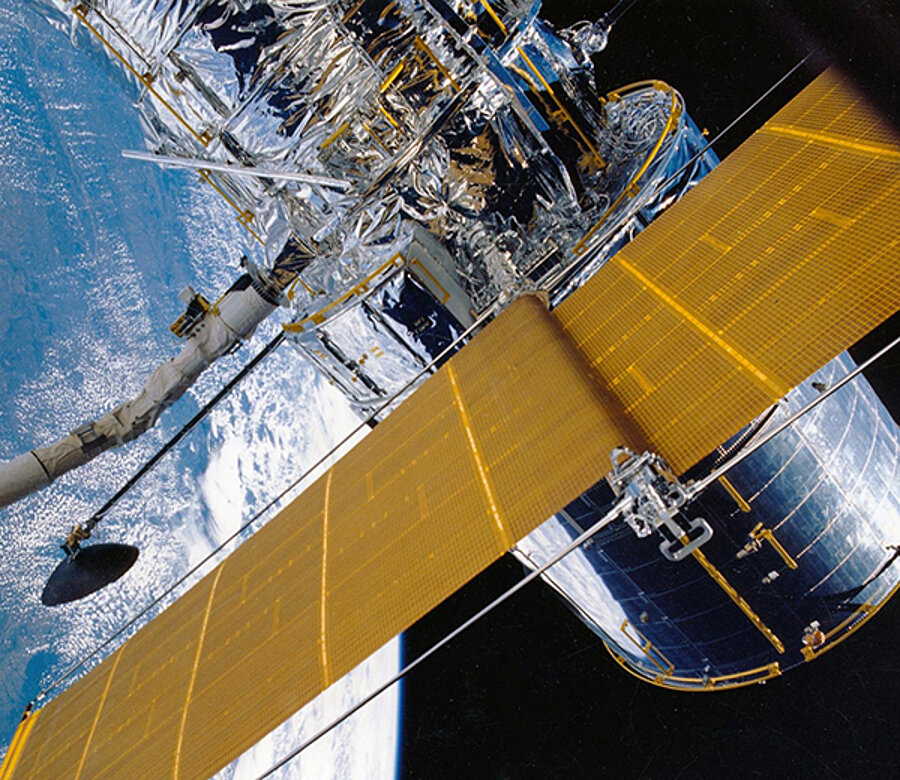Planet and Space Observation
Gathering Data for Weather Forecasts and Climate Prediction
HENSOLDT helps to lift the veil on the mysteries of space. One of the seemingly most pressing matters – affecting everyone – is the prediction of the weather. Meteorological data has been recorded for around 300 years. With space travel, weather observation from space became possible in the 1960s. Besides weather forecasts, this data is used for quantitative climate research – and becoming ever more precise. With its multispectral imaging radiometer METImage, HENSOLDT contributes to the German Aerospace Center DLR’s EUMETSAT Polar System – Second Generation (EPS-SG) MetOp weather satellites.
Examining Planet Surface
HENSOLDT Optronics provides the key to correlating the information on planetary missions with topographical data.
This is why a HENSOLDT Optronics laser altimeter is on board satellite missions to our neighbouring planets. That very laser features prominently on the ESA’s outing to Mercury as part of the current BepiColombo mission. HENSOLDT Optronics lasers for space applications benefit from insights and experience gained with a world-class platform – its very successful laser rangefinders for military applications. The best practices and lessons learned with terrestrial lasers, paired with excellence in space instrumentation, enabled our engineers to vault into laser-assisted planetary observation and hit the ground running.
Our Laser Altimeter BELA is currently making its way to Mercury as part of the ESA mission BepiColombo. It will be employed to scan the surface of the red planet with an accuracy of approximately one metre, using diode laser-pumped Nd:YAG lasers, which have been in use at HENSOLDT Optronics since 2001 and have now been developed and designed for the use in space.
HENSOLDT is now working on its Laser Altimeter for GANYMED, the exploratory mission to examine Jupiter’s icy moons. This will be used in the JUICE mission (Jupiter Icy Moons Explorer) of the European Space Agency to measure the Jupiter moon Ganymede.
The same applies to HENSOLDT spectrographs, without which many NASA and ESA missions would be almost unthinkable today. Through the combination of spectral analysis and selective imaging, they are the central type of instrument for studying the physics of the universe and the nature of distant stars and galaxies.
When the James Webb Space Telescope succeeds Hubble in 2021, HENSOLDT technology will be on board. The joint project between the National Aeronautics and Space Administration (NASA), the European Space Agency (ESA) and the Canadian Space Agency (CSA) will study the beginnings of our universe and the history of the solar system with much more precision than the Hubble telescope. To do this, the telescope's mirrors must be incredibly accurate. Their rear wall, for example, must not move more than 38 nanometres - that is a millionth of a millimetre. HENSOLDT's filter wheel and grating wheel mechanisms help to ensure the precision required.
Reconnaissance in Space
Since the 1990’s, HENSOLDT‘s space electronics teams have supplied key technologies and core electronics for the Synthetic Aperture RADAR (SAR) Space Missions SRTM, TerraSAR-X, Tandem-X, PAZ (Spain), SARah and Kompsat-6 (South-Korea). These key technologies have proven excellent performance and successful operation in space and comprise: They include transmit/receive modules, digital control electronics and radio frequency electronics.
In 2018, HENSOLDT delivered the central radar electronics (CRE) component for SARah, the reconnaissance satellite of the German Armed Forces. HENSOLDT also delivers the NGSAR Quad Boards, the transmit/receive modules. NGSAR stands for Next Generation Synthetic Aperture Radar. SARah is HENSOLDT’s first project supplying space hardware for a military satellite. The German Bundeswehr’s reconnaissance system is designed to include three SARah satellites. HENSOLDT will provide the central radar electronics and quad boards for one of the three satellites as a subcontractor to Airbus.
Gathering Enviromental Data
Many NASA and ESA missions would be all but inconceivable without spectrographs. Combining spectral decomposition and selective imaging capabilities, these instruments are the best probes we have to study the nature of distant stars, galaxies and the remnants of the universe’s primordial history. This requires sophisticated optical telescopes, filters, coronographic apertures, slicing elements and diffractive elements as well as the ability to perform at cryogenic temperature with arcsec accuracy.
Hensoldt Optronics delivers components with precisely the capabilities that space spectrographs need. Built on the bedrock of half a century’s experience in space-borne optics, each component of every solution can be customised to your specifications.
Related products
We offer best solutions for planet and space observation.

